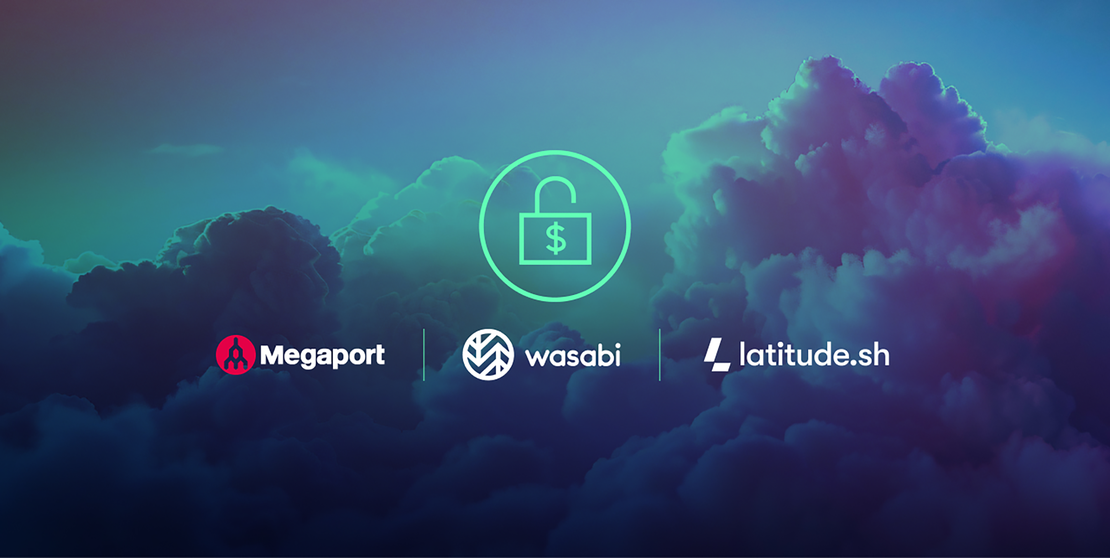
How Latitude.sh, Wasabi, and Megaport Unlock Cost-Effective Multicloud
- Integrations
- April 30, 2025
- RSS Feed
By Dan Pfyl, Solutions Architect
Learn how to reduce cloud costs without sacrificing performance by integrating Latitude.sh's compute, Wasabi's storage, and Megaport's private network into your multicloud architecture.
IT teams are under increasing pressure to reduce costs without sacrificing performance or scalability in their cloud infrastructure.
I’ve had several customers bring up a need for reducing compute cost and storage costs, the need for custom hardware specs, and the like. We have some interesting providers on our network that can help with this by supporting a lower-cost custom infrastructure solution while maintaining mission-critical level performance.
In this blog, I’ve pieced together what I think is a high-value, low-cost alternate solution to traditional hyperscalers like AWS, Microsoft Azure, and Google Cloud. Latitude.sh plays a key role in this setup by providing a bare metal compute stack, while using Wasabi Cloud network-attached storage (NAS) as the database repository needed for the applications running in the Latitude.sh platform.
When interconnected via Megaport’s private integrated network, this Latitude.sh and Wasabi solution will deliver a high-value, low-cost infrastructure perfect for IT teams looking to reduce cost while maintaining mission critical performance.
Why organizations are looking beyond just hyperscalers
Hyperscalers will forever have value thanks to their scale and breadth of features. But as businesses expand their multicloud architectures with more providers, on-ramps, and features—and as storage and compute needs continue to increase—cost pressures and availability are driving exploration of alternatives. Some specialized cloud service providers are driving this exploration, with lower-cost offerings that rival the performance of the hyperscalers.
Traditionally, adding extra service providers comes with prohibitive cost, performance, and agility challenges. And with specialized clouds accessed in different geographic locations than other hyperscaler services, cross-cloud applications running between them can cause issues with latency and jitter.
To mitigate this, private network solutions are necessary – but traditional options can’t scale, negating the cost and agility benefits of adding specialized clouds in the first place.
In these cases, an integrated Network as a Service solution like Megaport is necessary to unlock higher performance, lower costs, and flexibility on mission-critical workloads. In an integrated private network ecosystem, service providers are already on-net and accessible instantly by creating a Virtual Cross Connect (VXC) from any access point. Users can then deploy virtual networking services to handle tasks like routing between clouds, removing the need for any physical hardware in a multicloud solution.
By combining low-cost, high-performance storage and compute solutions from specialized cloud service providers with an integrated private network ecosystem like Megaport’s, you can remedy the challenges of your mission-critical multicloud architecture – and pave the way for an endless combination of services to power all your other workloads and applications.
About Latitude.sh
Latitude.sh provides powerful, rock-solid bare metal servers and a software platform that delivers huge amounts of processing power and low latency across its connected locations. The dedicated, high-performance bare metal servers of Latitude.sh are optimized for today’s digital economy and provide businesses access to a globally distributed node infrastructure for AI, Web3 and crypto, gaming, container workloads, and video streaming.
These simple, affordable, and optimized compute and GPU services bring new use cases to your network at a lower cost than the traditional larger hyperscalers.
About Wasabi
Wasabi is redefining cloud storage, and is on a mission to make data storage simple, affordable, predictable, and secure. If you have data to store—whether it’s backups, medical images, surveillance videos, financial data, multimedia, or scientific data—Wasabi provides cost-effective, performance-driven solutions with low costs.
The role of private interconnectivity
The network connectivity you use for these connections remains critical to the performance and efficiency of these services. Using a private connectivity provider like Megaport for your Layer 2 and Layer 3 connectivity serves as the glue that ties everything together, providing a huge list of benefits to your network:
Improved performance
- Seamlessly move workloads between providers and on-premises locations over secure private connections.
- Reduce latency with scalable bandwidth and private connections unaffected by the fluctuations of the public internet.
Reduced costs
- Reduce egress fees from the large hyperscalers like AWS, Microsoft Azure, Google, Oracle, etc.
- Rightsize bandwidth on demand with pay-as-you-go billing to eliminate overprovisioning costs.
Other benefits
- Support the growth of your network over time with the ability to leverage easy expansion and scalability, with access to the provider’s enabled locations.
- Improve security with private connectivity and the ability to add security functions like Virtual Router services, FWaaS, and SD-WAN.
- Interconnect other types of providers including MSPs, storage and compute, and AI.
- Improve reliability with redundant connections and reduced downtime.
- Simplify virtual management.
Benefits of Wasabi, Latitude, and Megaport
- Lower TCO.
- Simplified multicloud management.
- Flexibility to scale and adapt infrastructure as needed.
Optimize cloud costs with Wasabi’s Cloud Cost Optimization eBook.
Use cases for Wasabi, Latitude, and Megaport
If your company is looking to deploy high-performance servers in seconds, without the unnecessary complications or clutter, you can deploy and manage Latitude.sh bare metal servers or dedicated GPU instances at the speed of the cloud. Coupled with Wasabi’s secure storage platform and Megaport’s elastic connectivity, you can deploy a multicloud setup for almost any use case.
Here are two potential solutions you could integrate into your network infrastructure.
Use case 1: Reducing costs for bandwidth-intensive GPU workloads
- Leverage Latitude for compute.
- Store related data in Wasabi’s scalable, low-cost cloud storage.
- Use Megaport for high-speed, private connectivity between providers with a predictable cost.
Use case 2: Storage optimization for data-heavy applications
- Wasabi functions as the primary storage platform.
- Use Latitude for compute at the edge.
- Megaport enables fast, secure data transfer between storage and compute layers along with a predictable cost.

Want to take a deeper dive into these use cases? Check out our complete guide to multicloud for more optimization tips, or book a personalized demo with our friendly Solutions team.





